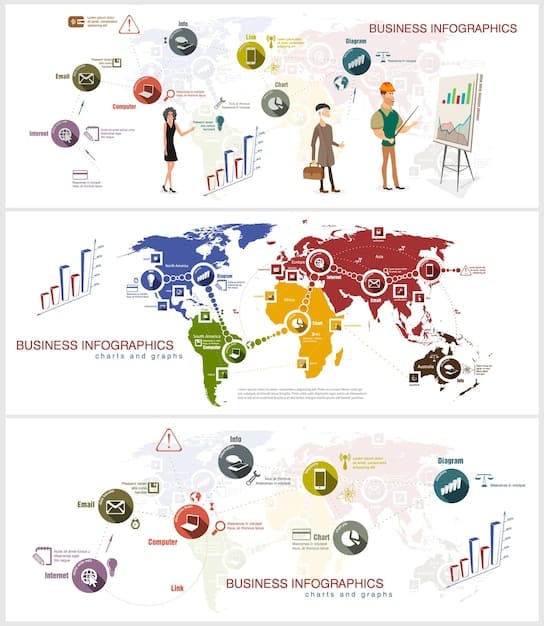US Businesses: Emerging Market Opportunities Await

Advertisements
Navigating the complexities of expanding into emerging economies presents significant opportunities for US businesses to achieve robust growth and diversify their global footprint by leveraging untapped potential and evolving consumer landscapes.
Advertisements
In an increasingly interconnected global economy, the quest for sustained expansion often leads businesses beyond their domestic borders. For US enterprises, the strategic imperative of Exploring New Markets: Opportunities for US Businesses in Emerging Economies presents a compelling narrative of growth, resilience, and unparalleled potential.
The Strategic Imperative of Emerging Markets
The global economic landscape is constantly shifting, and what was once considered the periphery is now often the vanguard of growth. Emerging markets, characterized by rapid industrialization, growing middle classes, and increasing integration into the global financial system, offer a compelling alternative to saturated domestic markets.
Advertisements
For US businesses, understanding the strategic benefits of these regions is crucial. It’s not merely about market access; it’s about securing future revenue streams, diversifying risk, and fostering innovation through exposure to new challenges and consumer preferences.
Drivers of Growth in Emerging Economies
Several fundamental factors underpin the allure of emerging markets. These economies are often dynamic, with robust demographic trends and significant infrastructure developments.
- Demographic Dividends: Young, growing populations translate into an expanding workforce and consumer base.
- Urbanization Trends: Rapid shifts from rural to urban areas create new demand for goods, services, and infrastructure.
- Digital Transformation: Leaping directly to advanced technologies in many sectors, bypassing older models, offers unique advantages.
Beyond demographics, these markets are also becoming increasingly sophisticated. Regulatory frameworks are evolving, often becoming more transparent and conducive to foreign investment, while regional trade agreements are fostering greater economic integration and reduced barriers to entry for foreign businesses, making the prospect of entry more appealing and manageable.
Ultimately, the strategic imperative is clear: to remain competitive and achieve sustainable growth in the 21st century, US businesses must look beyond traditional markets and actively seek out the burgeoning opportunities that emerging economies present. This proactive approach not only expands market share but also builds a more resilient and globally integrated business model that can withstand various economic fluctuations and secure a dominant position in future global trade.
Identifying Promising Emerging Markets for US Investment
Identifying the most promising emerging markets is more art than science, requiring a nuanced understanding of economic indicators, geopolitical stability, and cultural landscapes. For US businesses, a granular approach is essential, moving beyond broad categorizations to pinpoint specific nations or even regions within them.
This process begins with robust market research, analyzing everything from GDP growth rates and consumer spending habits to political risk assessments and regulatory environments. A deep dive into these data points helps to filter out less viable options and highlight those with the greatest potential for a secure and profitable return on investment.

Key Factors for Market Selection
When evaluating emerging markets, several critical factors should guide decision-making. These go beyond mere economic size to encompass the foundational elements that support sustained growth and a favorable business climate.
- Economic Stability and Growth: Look for consistent GDP growth, controlled inflation, and sound fiscal policies.
- Regulatory Environment: Transparent, predictable, and supportive legal and regulatory frameworks are paramount.
- Infrastructure Development: Adequate transportation, communication, and energy infrastructure is vital for operations.
Beyond these, cultural compatibility and the ease of doing business are also crucial, often overlooked aspects. Understanding local customs, consumer preferences, and the unwritten rules of commerce can significantly impact success, turning potential challenges into competitive advantages.
Countries often cited for their strong growth prospects and increasing openness include Vietnam, Indonesia, and specific sub-Saharan African nations like Kenya and Nigeria. Each offers a unique blend of opportunities and challenges, requiring tailored strategies. For example, Vietnam’s burgeoning manufacturing sector and young, tech-savvy population present opportunities for tech and consumer goods, while Indonesia’s vast domestic market and natural resources appeal to manufacturing and energy firms.
The goal is to move beyond conventional wisdom and identify markets align with specific business capabilities and long-term strategic objectives. By carefully weighing these factors, US businesses can make informed decisions that lead to sustainable and profitable expansion into the world’s most dynamic economic regions.
Navigating Regulatory and Political Landscapes
Entering new markets, especially emerging ones, inherently involves navigating diverse regulatory and political landscapes. This aspect is often cited as one of the most challenging, yet it is also one where careful preparation and local expertise can provide a significant competitive advantage. Understanding and adapting to these conditions is not merely about compliance; it’s about building trust and achieving long-term sustainability.
The regulatory environment in emerging markets can be complex, often characterized by frequent changes, varying enforcement, and sometimes, a lack of transparency. Political stability, while improving in many regions, remains a critical consideration, as sudden shifts can impact business operations and investment security.
Understanding Legal Frameworks and Business Operations
A thorough understanding of local legal frameworks is non-negotiable. This includes laws pertaining to foreign investment, taxation, labor, intellectual property, and environmental regulations. Ignorance of these laws can lead to significant penalties, operational disruptions, and reputational damage.
- Foreign Investment Laws: Restrictions on ownership, capital repatriation, and profit remittances.
- Taxation Systems: Corporate taxes, import/export duties, and local levies unique to the market.
- Intellectual Property Rights: Enforcement mechanisms and protection for patents, trademarks, and copyrights.
Beyond formal laws, businesses must also grasp the unwritten rules and informal practices that often influence the pace and nature of commerce. Building strong local relationships and engaging with local legal counsel are indispensable steps in this process, providing invaluable insights into the practical application of laws and regulations.
Political risk assessment is equally vital. This involves evaluating the potential for political instability, government intervention, or policy shifts that could impact business operations. Factors such as electoral cycles, social unrest, and geopolitical tensions must be monitored closely to anticipate and mitigate potential disruptions. Adapting to these environments requires flexibility, resilience, and a willingness to engage constructively with local authorities. Companies that demonstrate a genuine commitment to local development and adhere to ethical business practices often find more welcoming environments, even amidst political complexities.
Ultimately, successful entry into emerging markets hinges on meticulous due diligence regarding their legal and political frameworks. By treating these challenges not as roadblocks but as integral parts of the market entry strategy, US businesses can establish a robust foundation for enduring success.
Building Effective Market Entry Strategies for US Firms
Developing an effective market entry strategy is paramount for US firms venturing into emerging economies. A “one-size-fits-all” approach rarely succeeds; instead, a strategy must be tailored to the specific nuances of the target market, taking into account its unique economic, cultural, and political landscape. This requires a comprehensive understanding of local consumer behavior, competitive dynamics, and logistical challenges, ensuring that the chosen entry mode aligns with long-term business objectives.
The choice of entry mode—whether direct exporting, licensing, joint ventures, or wholly owned subsidiaries—depends on a myriad of factors, including the level of control desired, the financial resources available, and the perceived risks within the market. Each mode presents its own set of advantages and disadvantages, necessitating a careful evaluation of the trade-offs.
Common Market Entry Modes and Their Considerations
Different entry modes offer varying degrees of risk, control, and potential return. Understanding these distinctions is crucial for making an informed decision about how to penetrate a new market.
- Exporting: Low risk, low control, ideal for initial market testing. May involve indirect or direct methods.
- Licensing & Franchising: Moderate risk, moderate control, leverages local expertise with minimal capital outlay.
- Joint Ventures: Higher risk, higher potential return, shared resources and risks with a local partner.
- Wholly Owned Subsidiaries: Highest risk, full control, requires significant capital and local knowledge.
For many US businesses, particularly those new to emerging markets, a phased approach can be beneficial. Starting with lower-risk entry modes like exporting or licensing can provide valuable insights and build market understanding before committing to more significant investments like joint ventures or wholly owned subsidiaries. This iterative process allows for learning and adaptation.

Furthermore, strong local partnerships are often critical, especially in markets with complex regulatory environments or those where local insights are indispensable. A well-chosen local partner can provide crucial market knowledge, navigate bureaucratic hurdles, and help establish trust with local stakeholders. The success of any entry strategy also relies heavily on cultural sensitivity and adaptation of products or services to meet local tastes and needs. What works in the US may not resonate in a different cultural context, emphasizing the need for localized marketing, distribution, and product development.
In essence, building an effective market entry strategy for US firms means meticulously planning, being flexible, and adapting to the unique contours of each emerging market. It’s about combining global expertise with local insight to forge a path to sustainable growth and profitability.
Leveraging Technology and Innovation for Market Advantage
In the dynamic landscape of emerging economies, technology and innovation are not just tools but foundational pillars for achieving market advantage. For US businesses, leveraging their technological prowess and innovative spirit can unlock unparalleled opportunities, differentiate their offerings, and streamline operations in diverse and often challenging environments. Digital transformation, in particular, is reshaping industries and consumer behaviors across these markets, creating new avenues for engagement and growth.
From advanced manufacturing techniques to sophisticated digital payment systems, US firms can introduce cutting-edge solutions that solve local problems, improve efficiencies, and enhance the quality of life for consumers. This capability to innovate can significantly reduce lead times, optimize supply chains, and foster greater connectivity between businesses and their target audiences.
Digital Transformation as a Catalyst for Growth
Emerging markets are often characterized by a leapfrog phenomenon, where they skip traditional stages of technological development and embrace advanced digital solutions directly. This creates a fertile ground for innovative digital business models.
- Mobile Penetration: High mobile adoption rates drive e-commerce, digital payments, and mobile-first services.
- E-commerce Growth: Rapid expansion of online retail channels, catering to evolving consumer habits.
- Logistics Innovation: Use of data analytics and AI to optimize supply chain and last-mile delivery challenges.
Moreover, the adoption of cloud computing, artificial intelligence (AI), and the Internet of Things (IoT) can provide US businesses with robust tools for data analysis, personalized marketing, and operational intelligence, allowing for more agile and responsive market strategies. This allows for predictive analytics that can anticipate demand shifts and optimize inventory, reducing waste and increasing profitability.
Innovation extends beyond digital technologies to include business model innovation. Adapting existing products or creating entirely new ones to fit local consumer needs, pricing sensitivities, and distribution channels can open up vast segments of the population previously underserved. For example, offering scaled-down versions of premium products or developing affordable service packages tailored to lower-income demographics can create significant market inroads.
Furthermore, fostering local innovation through partnerships with local startups, universities, or research institutions can create powerful symbiotic relationships. This not only provides access to local talent and ideas but also ensures that innovations are culturally resonant and address specific local challenges. By strategically deploying technology and embracing innovation, US businesses can not only gain a competitive edge but also contribute to the economic development of the emerging markets they enter, fostering a mutually beneficial relationship that stimulates long-term success.
Addressing Challenges and Mitigating Risks
While the opportunities in emerging markets are vast, they are not without their challenges and risks. For US businesses, a realistic and proactive approach to identifying and mitigating these obstacles is crucial for sustainable success. Ignoring potential pitfalls can lead to significant financial losses, reputational damage, and operational disruptions. The complexities range from economic instability and currency fluctuations to logistical hurdles and cultural misunderstandings.
A comprehensive risk assessment framework should be an integral part of any market entry strategy, covering political, economic, operational, and cultural risks. This continuous monitoring and adaptation are key to navigating the unpredictable nature of these markets, ensuring that businesses can respond effectively to unforeseen circumstances.
Common Challenges and Mitigation Strategies
Emerging markets often present a unique set of challenges that require tailored solutions and a resilient operational mindset. Understanding what these are upfront can help businesses prepare more effectively.
- Currency Volatility: Employ hedging strategies and diversify investment portfolios to minimize exposure.
- Logistical Bottlenecks: Invest in robust supply chain analytics, explore multiple transport options, and consider local partnerships.
- Talent Acquisition and Retention: Focus on competitive remuneration, attractive workplace culture, and local training programs.
Beyond these, cultural differences can pose significant challenges. Misunderstandings in communication, negotiation styles, and business etiquette can impede progress and damage relationships. Investing in cross-cultural training for expatriate and local staff can bridge these gaps, fostering better collaboration and mutual understanding. Building a strong local team is also critical, as local employees possess invaluable insights into the intricacies of the market and can act as cultural bridges.
Intellectual property protection is another area of concern. In some emerging markets, enforcement of IP laws may be weak, leading to counterfeiting or unauthorized use of patented technologies. Businesses should register their intellectual property locally, monitor the market for infringements, and pursue legal action when necessary. Diversifying revenue streams across multiple emerging markets can also help mitigate risk by ensuring that a downturn in one market does not cripple overall operations.
Ultimately, a successful strategy for engagement in emerging markets is built on a foundation of rigorous due diligence, adaptation, and resilience. By addressing challenges directly and implementing robust mitigation strategies, US businesses can transform potential obstacles into manageable hurdles, paving the way for profitable and sustainable growth in these dynamic economies.
The Long-Term Rewards of Emerging Market Engagement
Embarking on the journey into emerging markets is not merely a short-term tactical move for US businesses; it represents a strategic commitment to long-term growth and global competitive advantage. The myriad opportunities, when successfully navigated, translate into substantial and enduring rewards that extend far beyond immediate financial gains. These markets are shaping the future of the global economy, and early, effective engagement positions businesses to be architects of that future.
The long-term rewards are multifaceted, encompassing enhanced market share, diversified revenue streams, increased innovation, and a stronger global brand presence. Companies that dedicate themselves to understanding and serving these dynamic consumer bases are building foundations for future resilience and profitability.
Sustainable Growth and Diversification
One of the most significant long-term benefits is the potential for sustainable growth that offsets saturation in established markets. Emerging economies often offer higher growth trajectories, fueled by demographic trends, urbanization, and increasing consumer purchasing power.
- Market Share Expansion: Early entry allows for establishing strong market positions before competition intensifies.
- Revenue Diversification: Reduces reliance on single markets, mitigating regional economic downturns.
- Innovation Feedback Loops: Exposure to diverse consumer needs and competitive pressures fosters new product development and business model innovations.
Beyond market share, engaging in emerging markets also strengthens a company’s global brand. By demonstrating a commitment to these regions, businesses can build trust and loyalty among new consumer segments. This global footprint not only enhances reputation but also attracts diverse talent, enriching the organizational culture and broadening perspectives.
Furthermore, early engagement in these markets allows businesses to shape industry standards, influence regulatory developments, and build robust local ecosystems of partners and suppliers. This proactive positioning can create significant entry barriers for future competitors, solidifying a dominant market position. The challenges encountered in these markets often lead to valuable organizational learning, forcing companies to become more agile, innovative, and culturally intelligent—skills that are transferable and beneficial across all global operations.
In essence, the long-term rewards of exploring and successfully penetrating emerging markets are profound. They offer a pathway to sustained financial performance, strategic resilience, and an expanded global influence, making the initial investment and effort a worthwhile endeavor for any forward-thinking US business.
| Key Point | Brief Description |
|---|---|
| 📊 Market Potential | Emerging economies offer significant growth due to rising middle classes and rapid urbanization. |
| ⚖️ Regulatory Navigation | Understanding local laws and political stability is crucial for long-term success and risk mitigation. |
| 🌱 Strategic Entry | Tailored entry modes (e.g., joint ventures, exporting) align with market specifics and business objectives. |
| 💡 Innovation Leverage | Utilizing advanced technology and adapting products for local needs provides a competitive edge. |
Frequently Asked Questions About Emerging Market Expansion
▼
The primary benefits include accessing new customer bases, achieving higher growth rates than mature markets, diversifying revenue streams to reduce domestic market dependence, fostering innovation through exposure to new challenges, and enhancing global competitive positioning. These markets often offer untapped potential due to rapidly growing middle classes.
▼
Assessing political risk involves thorough due diligence, including analysis of government stability, electoral cycles, policy changes, and social unrest. Engaging with local political consultants, leveraging country risk reports, and maintaining strong local networks can provide crucial insights and help anticipate potential disruptions that impact operations and investments.
▼
Effective market entry strategies vary but often include direct exporting, licensing, franchising, joint ventures, or wholly owned subsidiaries. The best choice depends on factors like desired control, available resources, and local market characteristics. A phased approach, starting with lower-risk methods, is often recommended for initial market testing and learning.
▼
Yes, prioritizing technologies that align with the digital transformation trends in emerging markets is crucial. These include mobile-first solutions for e-commerce and payments, cloud computing for scalable operations, and data analytics/AI for market insights and supply chain optimization. Investing in localized digital infrastructure can yield significant returns.
▼
Cultural adaptation is immensely important for long-term success. Understanding local customs, consumer preferences, and business etiquette builds trust and avoids misunderstandings. Localizing products, marketing campaigns, and management styles based on cultural insights can significantly enhance market acceptance and foster deeper relationships with local stakeholders and customers.
Conclusion
The journey of Exploring New Markets: Opportunities for US Businesses in Emerging Economies offers a compelling pathway to enduring growth and global impact. While the path is paved with inherent complexities and demands meticulous planning, the rewards of diversification, increased market share, and enhanced innovation are undeniable. For US enterprises, embracing these dynamic landscapes signifies a strategic commitment to shaping their future, fostering resilience, and truly becoming global economic players. By approaching these markets with an informed, adaptable, and forward-thinking mindset, businesses can unlock their full potential and secure a competitive edge in the evolving global economy.





